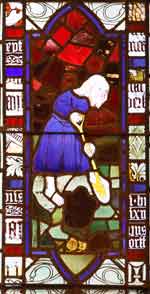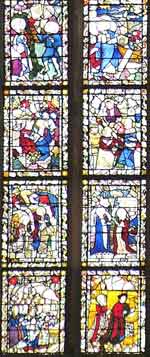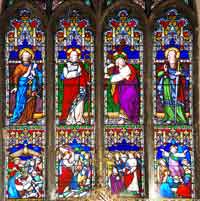Making Stained Glass
- Early Techniques
- Colouring pre 1300
- Colouring after 1300
- Making a Window
- Making Glass in the 19th Century
- Colouring Glass in the 19th Century
Transparent Glass Medieval Techniques
By the 12th century the techniques of making window glass blown by mouth had evolved and in fact remain much the same today. Transparent or ‘white’ glass was made from combining two parts sand to one of vegetal - ash plus a dash of lime (ground limestone) in a fire resistant clay pot which was heated in a wood - fired kiln at a temperature of around 1500C until they melted into a sticky mass. Despite its name glass made using these materials wometimes had a greenish tingle. As the mixture began to cool the glassmaker adopted one of two techniques:
- The Muff method: A lump was collected on the end of a narrow pipe and blown into the shape of an elongated balloon. When it was cooling the glass maker split it along its length and flattened it out. Glass sheets thus produced were probably no more that 25cm by 31cm in size and may be identified as any air bubbles found in the glass form straight parallel lines. Sometimes the straight edge of the sheet with a rounded cross-section, or ‘muff edge’ is found. White glass using this method was made in England in the Middle Ages in Staffordshire and the Sussex Weald.
- The Crown method: A lump was blown into a spherical shape, which was then attached to a metal rod or pontil opposite the blowing pipe, this was then broken off leaving a hole. The sphere was spun, enlarging the hole until the glass opened into a large disc until it was typically between 25cm – 50cm in diameter,although it could be significantly larger. Windows made using crown glass contain air bubbles, which take the form of widening concentric circles, and have curved edges. The central point where the rod was attached was the thickest point known as the bull’s eye. This was used to glaze small unimportant openings. This method was not introduced into England until the 17th century, but imported crown glass from Normandy was used in the medieval period.

It took up to four days for the glass to anneal (i.e. to complete the process of strengthening and hardening) which made it an expensive commodity. Nevertheless this technique remained largely unchanged until the 19th century
Colouring the Glass before 1300
By the 7th century it was discovered that if metal oxides were added to the minerals in the clay pot before it went in the kiln coloured glass could be produced. Copper was used to produce red, cobalt for blue, manganese for pink or purple, and iron oxide for various greens or a bright yellow. The final shade was determined by the amount of oxide added and the temperature applied when the mixture was fired. The resulting product was called 'pot metal glass'.
Red or ruby glass made in this way was too dark to use. To make a more transparent ruby, white glass was coated or 'flashed' with a layer of coloured glass by dipping a bubble of white glass into molten red glass before it was made into a muff or disc. Such flashed glass was more transparent than pot metal. Patterns and subtle details could be produced by abrading or scratching away parts of the thin layer of coloured glass with a flint, leaving the white glass visible. This technique was sometimes used for other colours.
Details of faces, background patterns etc could be painted onto the glass with a dark pigment (shaded from brown to black) made up of copper or iron oxide mixed with soft powdered glass and wine or urine. During this period the painting technique was not considered as part of the colouring process.
Colouring glass after 1300
Early in the 14th century it was discovered that if glass was painted with a silver compound, such as silver nitrate, then fired in the kiln for varying amounts of time, a range of yellow tones (ranging from lemon to orange) could be produced. If applied to blue glass, the silver compound produced patches of green, and if applied to red glass, patches of orange. The technique known as yellow or silver-staining enabled different hues to be shown in the same piece of glass. it was the perfect way to depict hair, halos and crowns. The stain required a second firing of the glass from that of the glass paint.
In the early 16th century a reddish coloured enamel paint called sanguine, also known as Jean Cousin, was used for flesh tints and other details. By the mid 16th century a whole range of enamel paints which could be applied to glass were being produced. Again they were made permanent by firing. This technology led to a total shift in artistic aims, because it was now possible to apply separate colours to one piece of glass, it was like painting in oils on a sheet of canvas. As a result lead joining was no longer necessarily used to provide an outline to a design; instead often its sole use was to hold the panes together. The designer’s aim was to conceal it rather than integrate it into the image.
Making a Window
The traditional way of making decorative window panels using lead glazing has changed little over the centuries, although it has been made easier through the introduction of more sophisticated tools such as the gas or electric soldering iron. It follows the following basic stages:
- A preliminary design (vidimus) is produced on a small scale for approval.
- A template of the window opening is made.
- A design (know as a cartoon) is drawn to scale. Until the 16th century when paper became a relatively inexpensive commodity, the drawing would be made on a whitewashed table. This includes broad lines to indicate lead strips which hold the piece of glass and the colours to be used.
- Sheets of glass are placed over the cartoon and cut to shape. In the Middle Ages the glass was cut by the application of a hot iron to give an approximate shape, then further glass was nibbled away to a more precise shape using a 'grozing iron'. In the 17th century diamond cutters were introduced, whilst today glaziers use a steel wheel cutter.
- The pieces of glass are laid over the cartoon and the details of the design are painted onto the glass, traced from the painting underneath. Line drawings (trace lines) are made with thin and thick washes which can be modelled by smearing or stippling, and some paint is removed (relieved) with a stick or needle to leave highlights. Paint is normally applied to the inside surface, but silver stain is applied to the back.
- The painted and stained glass is then fired in a kiln to fuse the paint permanently.
- When cooled the glass is laid over the cartoon and fixed together with strips of lead, which is ideal for the process, being flexible and durable. The lead strips (known as calmes or cames) are grooved with an H shaped cross section.
- As each strip of lead is slotted over a piece of glass it is held in place by closing nails until the next piece is inserted. When the panel is completed the leads are soldered at each joint with solder and a wax flux.

Transparent Glass making from the Nineteenth Century
In the early 19th century the Industrial Revolution had a huge efect on the glass making industry. At this time a new method of sheet glass production, the cylinder process, was developed. In 1832 Robert Lucas Chance was the first to adopt this method in Britain, by combining the process with his own design of machinery he could produce a much superior finished product. The cylinder method not only allowed mass production but also the option to make large sheets of glass. By 1841 the company was turning out more than 4,000 feet of glass per week to meet the enormous demand.Despite such innovations, antique glass blown by mouth continued to be made to order. However, new processes were developed:
- In 1889 the Norman Slab method was invented whereby glass was made by blowing the molten mixture into a box – shaped mould, which then produced five rectangular sheets. These could be made as a thick texture to create different effects.
- The Norman Slab technique was further refined in the 20th century in a technique called 'dalle de verre' whereby extremely thick slabs of glass could be made using the same basic method.
Colouring Glass from the Nineteenth Century
 The revival of stained glass making in the 19th century, highlighted a major problem. Production of high-quality pot metal glass was inhibited largely because medieval methods and techniques had been lost. As a result much of the glass produced was of an inferior visual quality.
The revival of stained glass making in the 19th century, highlighted a major problem. Production of high-quality pot metal glass was inhibited largely because medieval methods and techniques had been lost. As a result much of the glass produced was of an inferior visual quality.